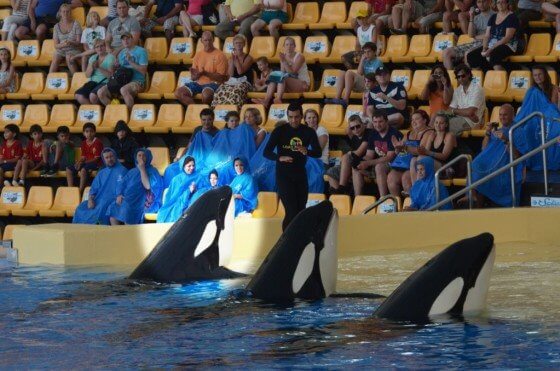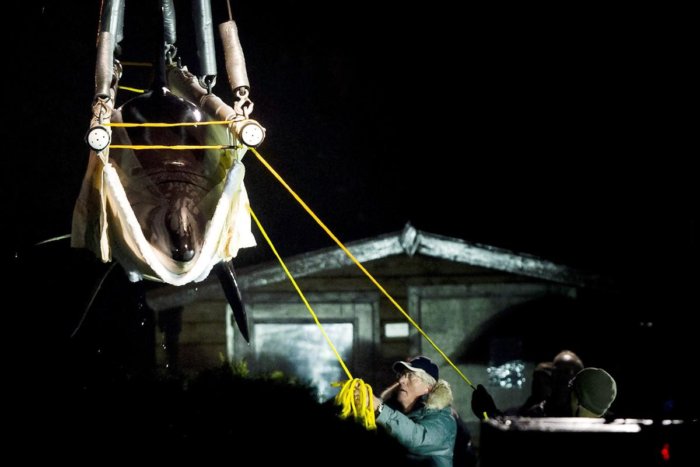Morgan: Rescue & Betrayal

Morgan was underweight and swimming alone when she was picked up off the coast of the Netherlands in 2010 and taken to a local theme park, the Dolfinarium Harderwijk, under a “rescue, rehabilitation and release” permit issued by the Dutch government.
A very good rehab and release outcome was at hand in the form of a seaside sanctuary in a cove in the Norwegian fishing village of Stø. The cove would have a net across its opening to the ocean, and there was a strong possibility that Morgan’s family would pass by there, enabling her to communicate with her pod and potentially to rejoin them.

Photo and illustration from Free Morgan Foundation.
The citizens of Stø were enthusiastic about hosting Morgan and helping to provide for her. “I am very positive about Morgan coming to our community,” the mayor said. “I will personally look forward to helping on her road to freedom.”
Rather than rehabilitating her, the dolfinarium kept her in a small tank for 18 months and taught her to do tricksHowever, rather than rehabilitating her, the Dolfinarium Harderwijk kept her in a small tank for 18 months and taught her to do tricks with a view to sending her to Loro Parque Zoo in the Canary Islands, off the west coast of tropical Africa.
To protect Morgan, a group of independent international experts and orca research and education organizations came together in the Netherlands to form a charitable organization, the Free Morgan Foundation, to advocate on behalf of Morgan.
At the hearings that followed, Loro Parque argued that European wildlife trade rules that prohibit the use of orcas for commercial purposes did not apply. Life in the zoo’s display tanks, they said, would give Morgan a better chance, and she would serve “educational” purposes.
Experts said this could not possibly be the case. An officer of Germany’s Federal Agency for Nature Conservation told the judge:
“It is agreed among the European experts that every zoo must be considered a commercial facility, in which research or education in most circumstances has either no priority or only secondary priority.”
The Dutch ministry that had authorized the move to Loro Parque admitted that it was relying on the word of Spanish authorities (the Canary Islands are a Spanish territory) that the zoo served conservation and educational purposes, even though it had no conservation program and its “education” program consisted of a few handouts and posters.
But the judge sided with the zoo and ordered that Morgan be flown to the Canary Islands 2,000 miles to the south.

Photo by Free Morgan Foundation.
Life at Loro Parque Zoo

Photo by Loro Parque
Soon after Morgan arrived at Loro Parque, the zoo began talking about her as though she was being integrated into their orca “family.” But Morgan could never be part of their family. For starters, five of the other six orcas had been born at SeaWorld parks in Orlando or San Diego. Three of them were fathered by Tilikum. Morgan’s lineage was completely different. She couldn’t truly fit in, and the other whales began ganging up on her.
Loro Parque had other close ties to SeaWorld, which regularly sent orcas, trainers and veterinarians from its facilities in the United States on loan to its transatlantic cousin.
And so, despite her trauma, Morgan found herself being regularly put in the same tank as Keto, an aggressive adolescent male from SeaWorld who had already fathered two calves at Loro Parque. (Both infants had been rejected by their troubled mother.)
The zoo’s owner said Morgan had been sent to him as a “donation from nature” and a “new blood line” for breeding.None of this gave pause to the zoo’s owner, Wolfgang Kiessling, who expressed delight over his new acquisition. Morgan, he said, had been sent to him as a “donation from nature” and a “new blood line” for breeding. (No mention of conservation or education.)
Meanwhile, Morgan’s health suffered. A 2016 study detailed numerous health and welfare issues, including that she had frequently been observed chewing on the concrete edge of her tank. Photos showed one of her teeth to be fractured, and others chipped and worn to the bone.
Among many other concerns are videos that show Morgan ramming her head into the heavy metal gate of a small medical tank, and show her “beaching herself” on the side of the display tank after a show.
Video from Inside Edition.
Morgan and her baby Ula
In December 2017, the zoo announced that Morgan was pregnant. The father was the aggressive young male Keto.
Loro Parque had simply ignored the fact that breeding Morgan was a violation of the conditions of her transfer and that European law expressly prohibits the use of a captive whale for breeding purposes. Instead of providing her chemical means of birth control, the zoo had pressed ahead with what the animal protection groups had feared all along: the zoo simply wanted more whales.
As a defender of Morgan’s “rights”, Loro Parque argued that being bred in captivity is “a natural right of each animal.”And so, clothing itself as a defender of Morgan’s “rights”, Loro Parque argued that being bred in captivity is “a natural right of each animal … [one that] cannot be repressed under any circumstances.”
For its part, SeaWorld had stood aside and allowed one of its own orcas to impregnate Morgan with no regard for the law or for the young whale’s continued suffering. Instead, SeaWorld quietly ended its relationship to Loro Parque, along with any effort or influence it could have had to dissuade the zoo from breeding yet more whales.
In September 2018, Morgan gave birth to a daughter, Ula, and the two immediately bonded. But just a few days later, the park separated mother from daughter, first of all on the pretext that Morgan had too little milk, and then saying it was for safety reasons. Since that time, there have been reports of her having a deformation of the skull, photo-toxic lesions, and a diseased left pectoral fin.
Video from Voice of the Orcas
In April 2021, Loro Parque noted its veterinarians’ concerns that Ula was “showing signs of an intestinal problem.” Over subsequent weeks, they reported that her mood had improved but that there were “still perceived signs of inflammation and intestinal distension.”
On August 9th, the zoo announced that Ula had died. The statement spoke of its own “immense pain and sadness,” but said nothing about the young calf’s mother, Morgan, and the grief that we know she must be experiencing. Please see our blog post for a comment on what this glaring omission tells us.